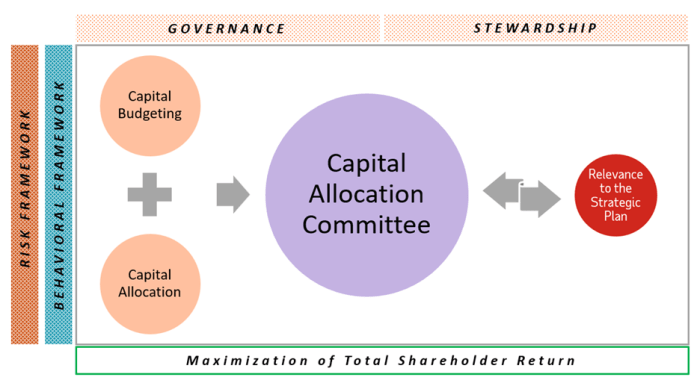
Strategic Capital Allocation sets the stage for this enthralling narrative, offering readers a glimpse into a story that is rich in detail with casual formal language style and brimming with originality from the outset.
Strategic capital allocation is a critical aspect of financial management that involves making informed decisions on where to invest resources for long-term growth and success. This strategic approach ensures that companies maximize their capital by allocating it wisely across various investment opportunities. Throughout this discussion, we will delve into the intricacies of strategic capital allocation, exploring successful examples, key influencing factors, and effective strategies that businesses employ to achieve their financial goals.
Strategic Capital Allocation

Strategic capital allocation refers to the process of determining how a company’s financial resources should be distributed among different investment opportunities to achieve long-term growth and maximize shareholder value.
Examples of Successful Strategic Capital Allocation
- Apple’s decision to invest in developing the iPhone, which revolutionized the smartphone industry and significantly boosted the company’s revenue and market share.
- Amazon’s strategic acquisitions of companies like Whole Foods and Ring, which expanded its offerings and customer base, leading to increased profitability.
- Google’s investment in artificial intelligence and cloud computing technologies, positioning the company as a leader in these emerging fields and driving future growth.
The Importance of Strategic Capital Allocation in Long-Term Growth
Effective strategic capital allocation is crucial for companies to achieve sustainable growth and remain competitive in the market. By allocating resources wisely to high-return projects, companies can generate value for shareholders and ensure long-term success.
Factors Influencing Capital Allocation Decisions

Capital allocation decisions are crucial for the success of any organization. Several key factors influence these decisions, shaping the strategic direction and financial health of the company.
Risk Assessment in Capital Allocation
Risk assessment is a critical aspect of capital allocation decisions. Before allocating capital to various projects or investments, companies must evaluate the potential risks involved. This involves analyzing factors such as market volatility, regulatory changes, operational risks, and financial uncertainties. By assessing and quantifying these risks, organizations can make informed decisions to optimize their capital allocation strategies and minimize potential losses.
Impact of Market Conditions on Capital Allocation Strategies
Market conditions play a significant role in shaping capital allocation strategies. Fluctuations in the market, changes in consumer behavior, economic trends, and competitive landscapes can all impact how organizations allocate their capital. For instance, during periods of economic uncertainty, companies may choose to allocate more capital to low-risk investments or focus on cost-saving initiatives. On the other hand, in times of growth and opportunity, organizations may allocate more capital to expansion projects or strategic acquisitions to capitalize on market trends and maximize returns.
Capital Allocation Strategies
Capital allocation strategies play a crucial role in shaping the financial future of a company. By carefully choosing how to deploy their resources, companies can drive growth, reward shareholders, and enhance overall value.
Comparing Different Strategies
Companies have various options when it comes to allocating capital, including growth investments, dividends, and share buybacks. Each strategy serves a different purpose and comes with its own set of benefits and considerations.
- Growth Investments: Companies can choose to reinvest profits into projects that aim to expand the business, develop new products, or enter new markets. These investments are crucial for driving long-term value creation and maintaining competitiveness.
- Dividends: By paying out a portion of profits to shareholders, companies can provide a steady income stream and attract investors seeking stable returns. Dividends are often favored by income-oriented investors looking for regular payouts.
- Share Buybacks: Companies can repurchase their own shares from the open market, effectively reducing the number of shares outstanding. This can boost earnings per share and signal confidence in the company’s future prospects.
Prioritizing Strategies
Companies need to carefully consider their financial goals, current market conditions, and growth prospects when deciding how to allocate capital. For example, a high-growth tech company may prioritize reinvesting in R&D and expansion to fuel innovation, while a mature company in a stable industry might focus on returning value to shareholders through dividends.
Role in Achieving Financial Goals
Effective capital allocation is essential for achieving financial goals such as revenue growth, profitability, and shareholder value. By aligning capital allocation strategies with overall business objectives, companies can optimize their resource utilization and drive sustainable long-term success.
Capital Growth
Capital growth refers to the increase in the value of assets over time, which is crucial for the long-term success and sustainability of a business. It allows companies to expand, invest in new opportunities, and generate higher returns for shareholders.
Importance of Capital Growth
Capital growth is essential for businesses as it enables them to increase their market value, attract investors, and stay competitive in the industry. By achieving sustainable growth, companies can strengthen their financial position and create more opportunities for future expansion.
Strategic Capital Allocation for Capital Growth
Strategic capital allocation plays a vital role in driving capital growth for businesses. By effectively allocating resources to high-return projects, companies can maximize their profitability and accelerate their growth trajectory. This involves identifying and investing in opportunities that offer the highest potential for increasing value over time.
Examples of Companies Achieving Capital Growth
- Apple Inc.: Through strategic capital allocation, Apple has consistently invested in innovation and product development, leading to significant capital growth over the years. Their focus on high-margin products and services has enabled them to expand their market share and increase shareholder value.
- Amazon.com Inc.: Amazon’s strategic investments in technology, logistics, and new business ventures have driven substantial capital growth for the company. By diversifying their revenue streams and expanding into new markets, Amazon has achieved remarkable success in increasing its market capitalization.
- Alphabet Inc. (Google): Alphabet’s strategic capital allocation approach has allowed them to fund ambitious projects such as self-driving cars and artificial intelligence initiatives. By prioritizing long-term growth opportunities, Google has experienced impressive capital growth and market dominance.
In conclusion, Strategic Capital Allocation emerges as a cornerstone for companies seeking sustainable growth and profitability. By carefully balancing investment options, considering risk factors, and aligning capital allocation with financial objectives, businesses can pave the way for long-term success in today’s dynamic market environment.
Questions Often Asked
What is the primary goal of strategic capital allocation?
The main goal is to optimize the use of available capital to achieve sustainable growth and maximize returns for the company.
How do market conditions influence capital allocation decisions?
Market conditions such as interest rates, economic stability, and industry trends can impact how companies allocate their capital to different investment opportunities.
What role does risk assessment play in strategic capital allocation?
Risk assessment helps companies evaluate the potential risks associated with different investment choices, allowing them to make informed decisions that align with their risk tolerance and financial goals.





